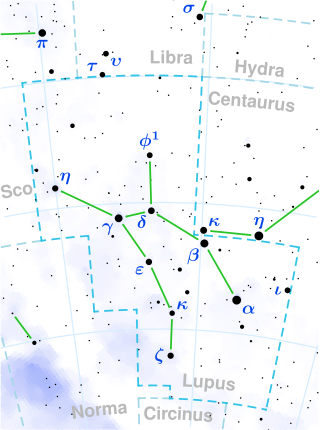
Back Gliese 588 AST Gliese 588 Spanish Gliese 588 Dutch Gliese 588 Polish Глизе 588 Russian 葛利澤588 Chinese
| Observation data Epoch J2000 Equinox J2000 | |
|---|---|
| Constellation | Lupus |
| Right ascension | 15h 32m 12.93186s[1] |
| Declination | −41° 16′ 32.1081″[1] |
| Apparent magnitude (V) | 9.311 |
| Characteristics | |
| Spectral type | M2.5V[2] |
| U−B color index | +1.14[3] |
| B−V color index | +1.51[3] |
| Astrometry | |
| Radial velocity (Rv) | 15.50 km/s |
| Proper motion (μ) | RA: -1176.447[4] mas/yr Dec.: -1030.9703[4] mas/yr |
| Parallax (π) | 168.9965 ± 0.0270 mas[4] |
| Distance | 19.300 ± 0.003 ly (5.9173 ± 0.0009 pc) |
| Absolute magnitude (MV) | 10.44[5] |
| Details[6] | |
| Mass | 0.43±0.05 M☉ |
| Radius | 0.42±0.03 R☉ |
| Surface gravity (log g) | 4.82±0.08 cgs |
| Temperature | 3555±41 K |
| Metallicity [Fe/H] | 0.06±0.08 dex |
| Rotation | 61.3±6.5 d[7] |
| Other designations | |
| Database references | |
| SIMBAD | data |
Location of Gliese 588 in the constellation Lupus | |
Gliese 588 is a nearby red dwarf star of spectral type M2.5, located in the constellation Lupus at 19.34 light-years from Earth.[1] It emits a very stable light flux, with no detectable pulsations.[6]
- ^ a b c van Leeuwen, F. (2007). "Validation of the new Hipparcos reduction". Astronomy and Astrophysics. 474 (2): 653–664. arXiv:0708.1752. Bibcode:2007A&A...474..653V. doi:10.1051/0004-6361:20078357. S2CID 18759600. Archived from the original on 7 December 2019. Retrieved 25 December 2016. Vizier catalog entry Archived 2 April 2019 at the Wayback Machine
- ^ a b "GJ 588". SIMBAD. Centre de données astronomiques de Strasbourg. Retrieved 25 December 2016.
- ^ a b Mermilliod, J.-C. (1986). "Compilation of Eggen's UBV data, transformed to UBV (unpublished)". Catalogue of Eggen's UBV Data. Bibcode:1986EgUBV........0M.
- ^ a b c Brown, A. G. A.; et al. (Gaia collaboration) (2021). "Gaia Early Data Release 3: Summary of the contents and survey properties". Astronomy & Astrophysics. 649: A1. arXiv:2012.01533. Bibcode:2021A&A...649A...1G. doi:10.1051/0004-6361/202039657. S2CID 227254300. (Erratum: doi:10.1051/0004-6361/202039657e). Gaia EDR3 record for this source at VizieR.
- ^ "The One Hundred Nearest Star Systems". 2012. Archived from the original on 26 March 2012. Retrieved 25 December 2016.
- ^ a b Berdiñas, Z. M.; Rodríguez-López, C.; Amado, P. J.; Anglada-Escudé, G.; Barnes, J. R.; MacDonald, J.; Zechmeister, M.; Sarmiento, L. F. (2017), "High-cadence spectroscopy of M-dwarfs – II. Searching for stellar pulsations with HARPS", Monthly Notices of the Royal Astronomical Society, 469 (4): 4268–4282, arXiv:1705.04690, doi:10.1093/mnras/stx1140
- ^ Suárez Mascareño, A.; Rebolo, R.; González Hernández, J. I.; Esposito, M. (2015), "Rotation periods of late-type dwarf stars from time series high-resolution spectroscopy of chromospheric indicators", Monthly Notices of the Royal Astronomical Society, 452 (3): 2745–2756, arXiv:1506.08039, Bibcode:2015MNRAS.452.2745S, doi:10.1093/mnras/stv1441
© MMXXIII Rich X Search. We shall prevail. All rights reserved. Rich X Search
